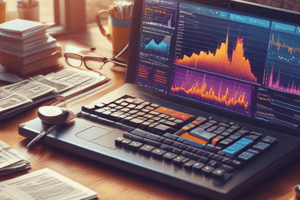Podcast
Questions and Answers
What are the four key items derived from financial statements that are crucial for credit analysis?
What are the four key items derived from financial statements that are crucial for credit analysis?
Key measures of cash flow, amount of debt obligations, cost to service debt obligations, and other sources of liquidity.
Explain the significance of EBITDA in leveraged finance credit analysis.
Explain the significance of EBITDA in leveraged finance credit analysis.
EBITDA is significant as it measures cash flow from operations available to service interest expense and other obligations.
What is the difference between EBITDA and EBIT?
What is the difference between EBITDA and EBIT?
EBITDA includes earnings before interest, taxes, depreciation, and amortization, while EBIT excludes depreciation and amortization.
How do interest rates impact a company's leverage?
How do interest rates impact a company's leverage?
What are debt incurrence tests and why are they important?
What are debt incurrence tests and why are they important?
In terms of credit analysis, what is the fixed charge coverage ratio?
In terms of credit analysis, what is the fixed charge coverage ratio?
What adjustments to EBITDA might be considered in credit analysis?
What adjustments to EBITDA might be considered in credit analysis?
Why is adjusted EBITDA preferred over traditional EBITDA in some analyses?
Why is adjusted EBITDA preferred over traditional EBITDA in some analyses?
How do you calculate EBITDA using net income?
How do you calculate EBITDA using net income?
What is adjusted EBITDA and why is it used?
What is adjusted EBITDA and why is it used?
What is OIBDA and how does it differ from EBITDA?
What is OIBDA and how does it differ from EBITDA?
What role does the statement of cash flows play in deriving EBITDA, especially when depreciation is not separately listed?
What role does the statement of cash flows play in deriving EBITDA, especially when depreciation is not separately listed?
Why is it important to include footnotes when reporting adjusted EBITDA?
Why is it important to include footnotes when reporting adjusted EBITDA?
In what situations might fixed charge coverage ratios be particularly useful?
In what situations might fixed charge coverage ratios be particularly useful?
How might changing interest rates impact a company's leverage?
How might changing interest rates impact a company's leverage?
What are the consequences of failing to clearly define terms in covenants related to EBITDA adjustments?
What are the consequences of failing to clearly define terms in covenants related to EBITDA adjustments?
What is the purpose of adjusting EBITDA when analyzing a company's financial performance?
What is the purpose of adjusting EBITDA when analyzing a company's financial performance?
How do capital expenditures differ from regular operating expenses in financial statements?
How do capital expenditures differ from regular operating expenses in financial statements?
What does the Fixed Charge Coverage Ratio measure in financial analysis?
What does the Fixed Charge Coverage Ratio measure in financial analysis?
In what way do interest rates impact a company's leverage?
In what way do interest rates impact a company's leverage?
What is unleveraged free cash flow and how is it related to capital expenditures?
What is unleveraged free cash flow and how is it related to capital expenditures?
Why is depreciation not considered a cash expense despite being recorded on the income statement?
Why is depreciation not considered a cash expense despite being recorded on the income statement?
What could be the implications for a company if its depreciation expense does not align with actual replacement costs of capital assets?
What could be the implications for a company if its depreciation expense does not align with actual replacement costs of capital assets?
How might rapidly evolving technology affect a company's capital expenditure decisions?
How might rapidly evolving technology affect a company's capital expenditure decisions?
Flashcards
EBITDA
EBITDA
Earnings Before Interest, Taxes, Depreciation, and Amortization. A measure of cash flow from operations.
EBITDA and Credit Analysis
EBITDA and Credit Analysis
Used to measure cash flow for debt servicing in leveraged finance credit analysis
Free Cash Flow
Free Cash Flow
Cash flow available after all business expenses and investments.
Debt Obligations
Debt Obligations
Signup and view all the flashcards
Cost to Service Debt
Cost to Service Debt
Signup and view all the flashcards
Liquidity
Liquidity
Signup and view all the flashcards
10-K
10-K
Signup and view all the flashcards
10-Q
10-Q
Signup and view all the flashcards
Adjusted EBITDA
Adjusted EBITDA
Signup and view all the flashcards
Statement of Cash Flows
Statement of Cash Flows
Signup and view all the flashcards
Net Cash Provided by Operating Activities
Net Cash Provided by Operating Activities
Signup and view all the flashcards
Depreciation and Amortization
Depreciation and Amortization
Signup and view all the flashcards
Stock Compensation
Stock Compensation
Signup and view all the flashcards
Write-downs of Asset Values
Write-downs of Asset Values
Signup and view all the flashcards
Capital Expenditures
Capital Expenditures
Signup and view all the flashcards
Where do Capital Expenditures appear?
Where do Capital Expenditures appear?
Signup and view all the flashcards
Depreciation
Depreciation
Signup and view all the flashcards
Impact of Depreciation on Cash Flow
Impact of Depreciation on Cash Flow
Signup and view all the flashcards
How Analysts Use Depreciation
How Analysts Use Depreciation
Signup and view all the flashcards
Unleveraged Free Cash Flow
Unleveraged Free Cash Flow
Signup and view all the flashcards
Investing Activities
Investing Activities
Signup and view all the flashcards
Straight-Line Depreciation
Straight-Line Depreciation
Signup and view all the flashcards
Study Notes
Book Title and Subtitle
- A Pragmatist's Guide to Leveraged Finance
- Credit Analysis for Bonds and Bank Debt
Author
- Robert S. Kricheff
Copyright and Disclaimer
- © 2012 by Robert S. Kricheff
- This book is sold with the understanding that neither the author nor the publisher is engaged in rendering legal, accounting, or other professional services or advice by publishing this book.
- Each individual situation is unique. If legal or financial advice or other expert assistance is required, the services of a competent professional should be sought.
- The author and the publisher disclaim any liability, loss, or risk resulting directly or indirectly, from the use or application of any of the contents of this book.
About the Author
- Robert S. Kricheff is a Managing Director and Head of the Americas High Yield Sector Strategy for Credit Suisse.
- He has more than 20 years of experience doing credit analysis.
- He has followed numerous industries, including media, cable, satellite, telecom, gaming, entertainment, healthcare, and energy.
- He has worked with emerging-market corporate debt.
- His work has covered investment vehicles including bonds, converts, loans, preferred stocks, and credit default swaps.
- He has a BA from New York University in economics and an MSc from the University of London SOAS in financial economics.
Acknowledgements
- Acknowledgements to John Lutz of McDermott Will & Emery LLP and Andrew N. Rosenberg of Paul, Weiss, Rifkind, Wharton & Garrison LLP
- and John Kolmer, a great person and boss.
Table Of Contents (Partial)
- Chapter 1: Introduction
- Chapter 2: Common Leveraged Finance Terms
- Chapter 3: Defining the Market and the Ratings Agencies
- Chapter 4: The Participants
- The Issuers
- The Sell Side
- The Buy Side
- Private Equity
- Chapter 5: Why Is Leveraged Finance Analysis Unique?
- Chapter 6: The Major Components of Analysis
- Chapter 7: Some Features of Bank Loans
- Chapter 8: A Primer on Prices, Yields, and Spreads
- Chapter 9: A Primer on Key Points of Financial Statement Analysis
- Chapter 10: Credit Ratios
- Chapter 11: Business Trend Analysis and Operational Ratios
- Chapter 12: Expectations, Modeling, and Scenarios
- Chapter 13: Structural Issues: Coupons
- Chapter 14: Structural Issues: Maturities, Calls, and Puts
- Chapter 15: Structural Issues: Ranking of Debt
- Chapter 16: Key Leveraged Finance Covenants
- Chapter 17: Amendments, Waivers, and Consents
- Chapter 18: Making Money or Losing It Off of News Events
- Chapter 19: Management and Ownership
- Chapter 20: I'm Looking at Debt, So Why Does Equity Matter?
- Chapter 21: Value, Relative Value, and Comparable Analysis
- Chapter 22: New Issuance
- Chapter 23: Distressed Credits, Bankruptcy, and Distressed Exchanges
- Chapter 24: Preparing a Credit Snapshot
- Chapter 25: The Investment Decision Process
- Chapter 26: Closing Comments
Studying That Suits You
Use AI to generate personalized quizzes and flashcards to suit your learning preferences.




